How to install a circulation pump
Circulation pumps are installed in heating systems with forced or natural circulation. They are needed to increase heat transfer and to be able to adjust the temperature in the room. Installing a circulation pump is not the most difficult task; if you have a minimum of skills, you can do it yourself, with your own hands.
The content of the article
What is a circulation pump and what is it for
A circulating pump is a device that changes the speed of movement of a liquid medium without changing pressure. In heating systems, it is installed for more efficient heating. In systems with forced circulation, it is an indispensable element, in gravitational ones, it can be installed if it is necessary to increase the thermal power. The installation of a circulation pump with several speeds makes it possible to change the amount of transferred heat depending on the outside temperature, thus maintaining a stable indoor temperature.
There are two types of such units - dry and wet rotor. Devices with a dry rotor have a high efficiency (about 80%), but they are very noisy and require regular maintenance. Units with a wet rotor operate almost silently, with normal quality of the coolant they can pump water without failures for more than 10 years. They have a lower efficiency (about 50%), but their characteristics are more than enough for heating any private house.
Read about the choice of a circulation pump for heating systems here.
Where to put
It is recommended to install a circulation pump after the boiler, before the first branch, but on the supply or return pipe - it doesn't matter. Modern units are made of materials that can tolerate temperatures up to 100-115 ° C. There are few heating systems that work with a hotter coolant, therefore considerations of a more "comfortable" temperature are untenable, but if you feel calmer, put it in the return line.
There is no difference in hydraulics - the boiler, and the rest of the system, it does not matter if there is a pump in the supply or return line. What matters is the correct installation, in terms of strapping, and the correct orientation of the rotor in space. Nothing else matters.
There is one important point at the installation site. If the heating system has two separate branches - on the right and left wings of the house or on the first and second floors - it makes sense to put a separate unit on each, and not one common one - directly after the boiler. Moreover, the same rule remains on these branches: immediately after the boiler, before the first branch in this heating circuit. This will make it possible to set the required thermal regime in each part of the house independently of the other, as well as save on heating in two-story houses. How? Due to the fact that the second floor is usually much warmer than the first and requires much less heat. In the presence of two pumps in the branch that goes up, the speed of movement of the coolant is set much less, and this allows you to burn less fuel, and without compromising the comfort of living.
Strapping
There are two types of heating systems - forced and natural circulation. Systems with forced circulation cannot work without a pump, with natural circulation they work, but in this mode they have a lower heat transfer. Nevertheless, less heat is still much better than no heat at all, because in areas where electricity is often cut off, the system is designed as a hydraulic system (with natural circulation), and then a pump is cut into it. This gives high efficiency and reliability of heating.It is clear that the installation of a circulation pump in these systems is different.
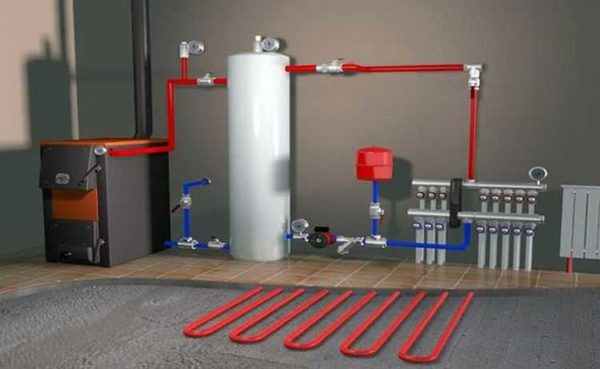
All heating systems with underfloor heating are forced - without a pump, the coolant will not pass through such large circuits
Forced circulation
Since the forced circulation heating system is inoperative without a pump, it is installed directly in the break in the supply or return pipe (of your choice).
Most problems with the circulation pump arise due to the presence of mechanical impurities (sand, other abrasive particles) in the coolant. They are able to jam the impeller and stop the motor. Therefore, a strainer-sump must be placed in front of the unit.
It is also desirable to install ball valves on both sides. They will make it possible to replace or repair the device without draining the coolant from the system. Turn off the taps, remove the unit. Only that part of the water that was directly in this piece of the system is drained.
Natural circulation
The piping of the circulation pump in gravity systems has one significant difference - a bypass is required. This is a jumper that makes the system operational when the pump is not running. One ball shut-off valve is placed on the bypass, which is closed, all the time while the pumping is running. In this mode, the system operates as forced.
When electricity fails or the unit fails, the crane on the lintel is opened, the crane leading to the pump is closed, the system works like a gravity system.
Installation features
There is one important point without which the installation of a circulation pump will require alteration: it is required to turn the rotor so that it is directed horizontally. The second point is the direction of the flow. There is an arrow on the body indicating which direction the coolant should flow. This is how you turn the unit so that the direction of movement of the coolant is "in the direction of the arrow".
The pump itself can be installed both horizontally and vertically, only when selecting a model, see that it can work in both positions. And one more thing: with a vertical arrangement, the power (created pressure) drops by about 30%. This must be taken into account when choosing a model.
Power connection
Circulation pumps are operating from a 220 V network. Connection - standard, a separate power line with a circuit breaker is desirable. Three wires are required for connection - phase, zero and ground.
The very connection to the network can be organized using a three-pin socket and plug. This method of connection is used if the pump comes with a connected power cable. It can also be connected via a terminal block or directly with a cable to the terminals.
The terminals are located under the plastic cover. We remove it by unscrewing a few bolts, we find three connectors. They are usually signed (there are pictograms N - neutral wire, L - phase, and "earth" has an international designation), it is difficult to make a mistake.
Since the entire system depends on the performance of the circulation pump, it makes sense to make a redundant power supply - to put a stabilizer with connected batteries. With such a power supply system, everything will work for several days, since the pump itself and the boiler automation "pull" electricity to a maximum of 250-300 W. But when organizing, you need to calculate everything and select the capacity of the batteries. The disadvantage of such a system is the need to ensure that the batteries are not discharged.

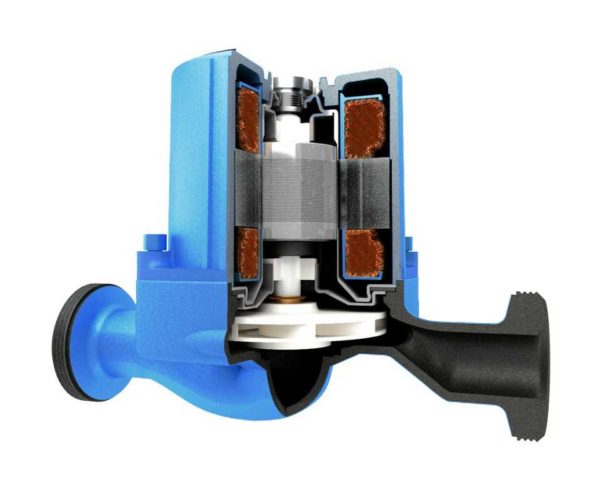
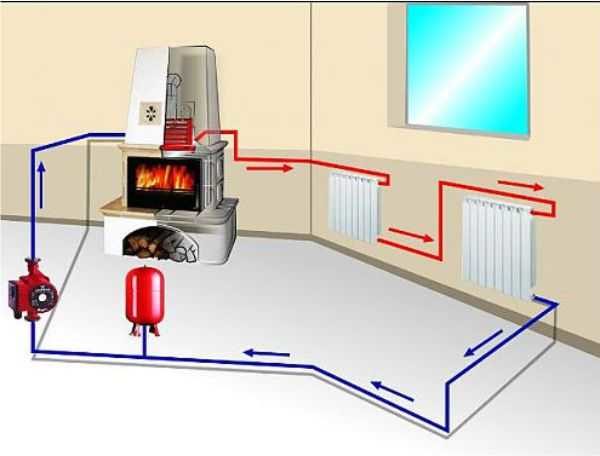
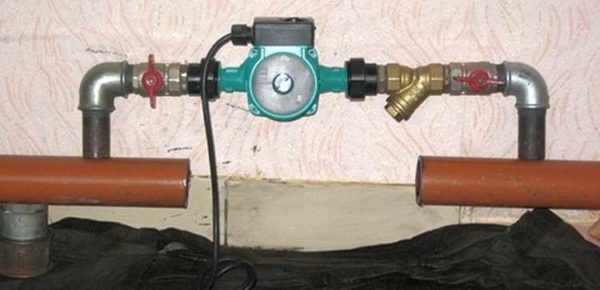
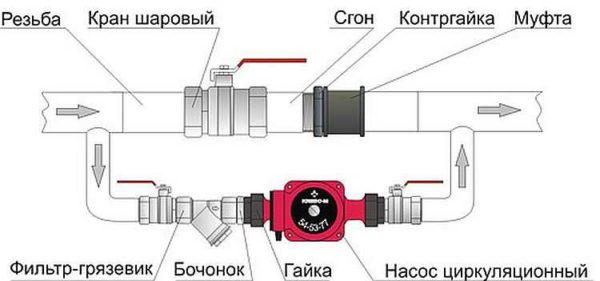
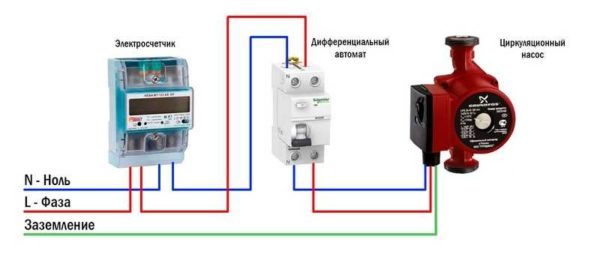
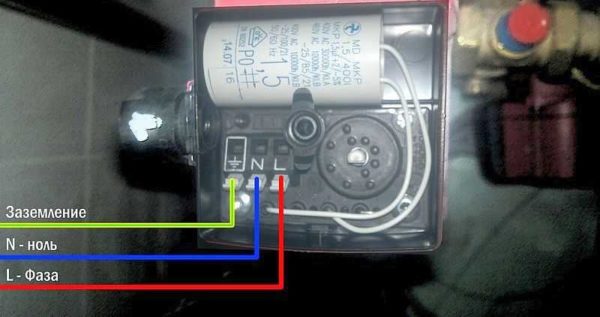
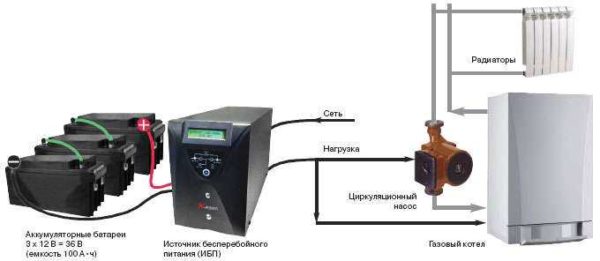
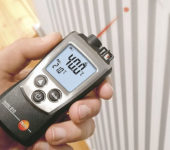
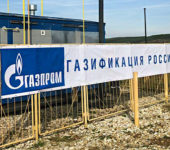
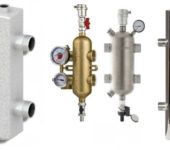

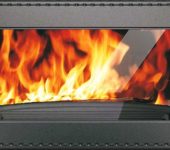





how to properly connect the pump to natural circulation heating for the selection of the coolant for euro batori
Hello. My situation, a 25 x 60 pump stands right after the 6 kW electric boiler, then the line from the 40 mm pipe goes to the bathhouse (there are three steel radiators) and returns to the boiler; after the pump, a branch up, then 4 m, down, rings a house of 50 sq. m. through the kitchen, then through the bedroom, where it doubles, then the hall, where it triples and flows into the boiler return; in the bath, a branch 40 mm upwards, comes out of the bath, enters the 2nd floor of a house of 40 sq. m. (there are two cast-iron radiators) and returns to the bath in the return; the heat did not go to the second floor; the idea of installing a second pump in the bath for supply after the branch; total pipeline length 125 m. How correct is the solution?
The idea is correct - the route is too long for one pump.
Hello. Is it better to put two pumps in series one after the other, or should there be some distance between them?
It makes more sense if the two circulation pumps are spaced apart. The movement of the coolant will be more uniform.
I have 2 pumps near the boiler, one in the flow, the other in the return. The total length is about 150 m. They have been working for 8 years.
Nobody said that you can't put one after another. You can and they work without problems. But you can also smash.
I had a house on 2 floors before there was heating: pipes throughout the house f80 half a tone of water boiler Dani now redid the heating pipe f25 batteries metal flat pump for some reason they cut into the return line although the far wing of the upper floor was previously cut into the flow, it may depend on the installation of the pump ?
We must look at the whole scheme. In principle, a circulation pump is installed in the return or in the supply - it does not matter. The main thing is that it has enough power. But due to a lack of power, the far wing may not heat up.
Hello! I would like to ask how to properly connect the pump to the boiler, it is on the return line, and when you plug it into the outlet, it starts to heat up very much and knocks out the machine! but there is no circulation (((all he turns there is no air in it!
Maybe the pump itself is faulty? When idle, he can turn the blades, but not with water. The second option is too narrow pipes or a blockage somewhere, but it is unlikely, otherwise the heating would not work well.
Hello. I bought a floor-standing gas boiler (TS) 12.5. I installed it, started it. The house is 50kv / m, plus 2 on the street, and 22 in the house. The boiler worked almost at maximum. One battery in my system is the very first on the highway. like appendicitis, that is, from the boiler, the main line turns to the right, and on this pavorot to the left under the window, pipes f20 are welded in, supply at the top and return at the bottom, cast-iron radiator 6 sections old, constantly cold, after installing a new boiler. the pump 25/4 is three-speed, in the first and second positions of the pump, the boiler began to work more quietly, the battery is also cold, the boiler works on 4, and the last highest position is 7, now on the street plus 4, and at home plus 22. need to do what is wrong?
So far, we can only make the conclusion that the coolant almost does not circulate through the cast-iron battery. Is it not clogged with slag? If everything is in order with the battery, then, as an option, you can change the system so that all the coolant passes through the cast-iron battery.
As for the boiler (as I understand it is 12.5 kW), then it should be more than enough for a house with an area of 100 sq. meters, and you have only 50. The conclusion is very simple - a small number of radiator sections. If "standard" aluminum radiators are installed, then I would recommend proceeding from the calculation of 1 section per 1.2 sq. meters, and not 1.7, as some craftsmen expect. More sections - less coolant temperature and "load" on the boiler.
Put shut-off valves on the first radiators along the way and press the flow rate.
In my situation, there is a heat accumulator in which a gas boiler heats water (a spiral from a bellows pipe is installed inside. I need to heat, let's say, utility rooms. I want to install a central heating pump on this separate heating system. There are several questions. 1. Is it necessary to create this system closed, with a certain pressure inside or the central pump can work according to the system - I took it from the tank, drove it through the system and freely dumped it into the battery? 2.Where is it better to install the central pump? to suck water from the tank on your own, without backwater, as in the first option? 3. What pump, with what parameters is it better to install? Utility rooms are small, the heating system is simple - three circuits made of m / plastic pipe 16 mm in diameter, without radiators, collectors are installed, the total length of the pipes is about 60 meters. The heat accumulator is concrete, the depth is 1 m. I would like to put a pump with a "wet" rotor, it makes less noise.
The circulating pump does not create pressure. It only accelerates the movement of the coolant. If you punch a hole at the bottom of the TA and create the right slope for water movement (like a natural circulation system), it should work. In this system, the circulating pump should be unambiguously set to supply and it is better if it has several speeds - for different weather. Find one with a wet rotor - great.
Thanks for the advice! After him, a mosaic in my head formed.))) While waiting for an answer, I went to a friend and looked at the disassembled central pump with a wet rotor. The impeller is thin and there really is nothing to create pressure there. boiler and I felt sorry for the boiler pump, therefore I decided to separate the two systems. After reading here on the site about different situations and your advice, I decided to abandon the heat accumulator altogether (I will find another use for it. I bought, as I wanted, a TsN with a wet rotor, installed it on the supply of the line of a separate heating system on the boipass (had to be done). The pump turned on, it works quietly, some kind of load is not felt. If suddenly there is a slight skew towards the auxiliary rooms, then it will be possible to adjust either the pump speed or using a manifold, there are taps an extreme case, standing on separate systems, a house and utility rooms. Only four hours have passed, but I see no reason for concern. Thanks again! PS So I wrote in detail l .... well, maybe someone will find my experience useful.
You did everything right. And thanks for the detailed explanations. This is really helpful.
Good day. The question is as follows. The boiler is double-circuit. I installed an additional circulation pump on the second floor. It works constantly even when hot water is turned on. Will the additional pump harm the three-way tap or even the boiler when the hot water heating is turned on? Is it necessary to make a circulation loop for an additional pump? The system is one-tube. Thank you!!!
The circulating pump does not generate pressure. It accelerates the movement of the coolant through the pipes. If there is no excessive pressure, it cannot damage the valve or the boiler. When the water heating is turned on, the circulator runs idle for some time. This is "not very" for him, but for the system as a whole it is absolutely safe.
Is it possible to install the pump at any other point or still before / after the boiler?
You can install a circulation pump anywhere in the system. It's just that it's usually more convenient near the boiler.
Thank you, it's just that it is not very convenient for me near the boiler. It is not aesthetically pleasing at the feed, but there is no place on the return
Good day! The pump began to hum and give vibration and hum to pipes throughout the house. With what it can be connected? This happened in the coming heating season, and in the summer they dismantled the old wood-burning boiler (when the gas boiler was installed, it was assumed that there would be interruptions in the gas supply and did not remove it, respectively, it was part of the system). So we assume that this may be due - could the old boiler take over this buzz? Or is it still the pump has already deteriorated ... please also specify how dangerous it is. Thanks in advance.
Most likely, the hum comes from vibration. And it may be associated with wear of the rotor part or blades. Even on the pump blades during the idle time, build-ups could form, which cause beats, maybe debris got during the repair ... In general, you need to see what happened to the pump and near it.
After installing the circular pump, the batteries in front of the installed pump have cooled down. We turn off the pump, the batteries heat up.
Have you tried to turn on the boiler stronger? It turns out that the water comes cooled down ... right?
The return line probably does not work.
Hello! I have a heating gas boiler "Taiga". The heating system is made with forced circulation of water. If the electricity supply is turned off, the water in the radiators cools down. My question is, when there is no electricity, the gas boiler can remain on, or it is also needed How does this affect the operation of the boiler?
Hello! If there is no water circulation in the system, the boiler must be turned off. The water can boil and rupture the heat exchanger ... Or install a small UPS for the circulation pump.
I have a non-standard question. Is it possible to put the pump in parallel with the boiler, at least temporarily
As I understand it, the boiler has a built-in pump, but does not pump the system? If yes, then you can put a second pump in parallel with the boiler, but a check valve will be needed. It is desirable that both pumps have the same power.
Good day! Please tell me the following. The pump is out of order 25/8 - 180 mm. It stood on the supply in front of the boiler on the PPR 32 pipe. The pump was 32/8 - 180mm in stock. Can I put it? There are transition nuts / fittings, it is troubling that it has a passage section larger than the main pipe. Is this an option? Thank you!
Can there be natural circulation through the circulation pump when the power supply of the circulation pump is off ??? There is no bypass.
There will be no natural circulation. If electricity is often cut off, then it makes sense to make a bypass.
How to connect a circulation pump so that it turns on when you turn on any of the three boiler stages?
Good day. Tell me please. I made an automation system for heating my private two-story house. The essence of the automation is as follows: two thermal relays (W1209). One controls the air temperature in the house, the second controls the temperature of the coolant (water), the sensor of which is screwed to the supply pipe of the electric boiler. The second thermostat serves for emergency mode, it turns off the heating elements in case of exceeding the critical temperature of the water in the heating system. The electric boiler has three heating elements, and is divided into two groups, two are connected in parallel and have a power of 3.5 kW, and the third is 1.8 kW. The automation system also has a relay that controls the on and off of the circulation pump. When either of the two groups of heating elements is on, or both, the pump is on, if the groups are off, then the pump is also off. The question is: is this pump operating mode safe for this system, or it is necessary to turn on the pump constantly, or it can apply a pump shutdown delay relay, for example, for 15-20 minutes.
In order not to inadvertently overheat the shades, I would delay the pump off.
Good day, everyone. When you open the ball valve, in addition to the pump, water does not enter the heating system. REASONS?
Good evening, I want to put a pump in a heating system with natural circulation, the question arises whether it is necessary to put it near the boiler? Or can it be put, roughly speaking, in the middle or at the end of the system?
The circulation pump can be installed anywhere in the heating system.
Hello, such a question: I already have a boiler with a pump, but out of 6 radiators only the first three heat up, the last practically does not reach heat, is it possible to put a pump in the middle of the system and will this fix my problem ??? The boiler is designed for 250kV and my 100 barely warms up.
Another circulator can be placed in the middle of the system and, perhaps, this will help. For a while. But the problem seems to be more complicated. And it is desirable to eliminate it. In this situation, you need to deal with the system. How old is your heating? So everything worked at first, or did the problems start later? If later, at what point? Have you inspected pipes / radiators for a long time? Is the pump in the boiler faulty? The boiler pump (if it is designed for a smaller area) should easily "push" your heating system. Was the air released? Maybe after the third radiator there is an airlock ... In general, you need to check everything step by step. There's a reason somewhere
Good afternoon. Does the circulation depend on low pressure in the heating system. Thank you in advance.
Low pressure may be the cause of poor circulation. Did you ask about this?
Hello! I put the pump on the return line almost in front of the boiler The first three batteries are always hot and then two go cold .. Often airy. Is it possible to squeeze out air locks by adding water? and how to properly air the system?
If air often appears, it seeps somewhere. Check all connections. If there are threaded ones - tighten a little. And to de-air in a standard way - using air valves or Mayevsky taps on radiators. Open the tap, wait for the air to come out. As an even stream of water runs, you can close it. Move on to the next radiator. Walk in a circle several times, until when you open the taps, water immediately runs without air.
How to connect the wires of the heating pump oasis and which wire
The electrical connection diagram of the circulation pump is in the passport.A three-core cable is connected to the terminals under the plastic cover. The main thing is not to confuse where the ground wire is - it is always yellow-green. It will need to be connected to ground, and there is a grounding sign on the terminal block. We screw into this contact. Blue wire - traditionally connected to the zero bus. On the pump block, this wire is marked with the letter N or N. The remaining color is fed to the phase. On the block, look for the letter L or L. If you turn on the pump into the outlet, there, too, attach the earthen yellow-green wire to the bottom contact, and the other two - no difference.
Return pump in front of the gas boiler. Two floors. The main line rises to the second floor, then descends to the first, the return line from the first rises to the second and returns to the boiler. The second floor is heated, the first is not. I tried to press down on the batteries of the second floor - a slight warming of the batteries on the first floor. Question: is it possible that the pump power is not enough to lower the hot water down the pipe? I replaced the pump with a powerful one (I don't remember the specification in blue). It was a simple red.
You replaced the pump with a more powerful one, but it still does not push the system?
Before installing the Ariston boiler with a built-in pump, I had a Thermo parapet boiler with a three-speed Grundfos pump (I don't remember the power). The house has two floors (about 100 squares), a polypropylene pipe with a diameter of only 20 mm, the "Leningrad" system. At first speed it pushed through, but not good enough. On the second, everything worked fine. I think that in your case, there is not enough pump power or something interferes with the circulation of the coolant. It happens that when soldering polypropylene, the passage narrows and the coolant does not circulate well.
good day! there is a hydraulic arrow for 3 circuits after the boiler, after which there are 3 pumps. One is 25 ~ 40, the second is 25 ~ 60 and the third is 25 ~ 40 alpha2. another pump is conceived for the return flow in front of the boiler. free pump available 25 ~ 60. Is it mono to put it on the reverse or do you need to buy 25 ~ 40?
Hello! Tell me, there is a pump on the hot water recirculation, it worked fine (the heated towel rails are hot), but recently it has begun to work poorly, it gets very hot, but it does not drive water. You unscrew the plug, steam comes out and it starts to work, and then again the situation is also
Hello! Is it possible to put the pump in the heating system itself in the house on the return flow about 15 meters from the boiler (we have a boiler in the dressing room).
in order to save energy, can a cyclic time relay be installed (5 min. work-5 min. rest) how will such a mode affect the start of the circulating pump?
Hello! 2-storey house of 128 squares, with an attached garage of 60 squares, a 2-circuit boiler Baksi Luna3 Comfort 310 kW with its built-in circulation pump, the system is divided into three branches: 1st floor, 2nd floor and a garage. The first floor is cool, so I want to additionally put another circulation pump on the return of the first floor, will it help for the heat transfer of the first floor, or is it not needed? If so, what are the conditions for its installation? For example, will check valves be needed on the return pipes of the 2nd floor and the garage?
Don't you consider the option of installing additional heating radiators on the ground floor?